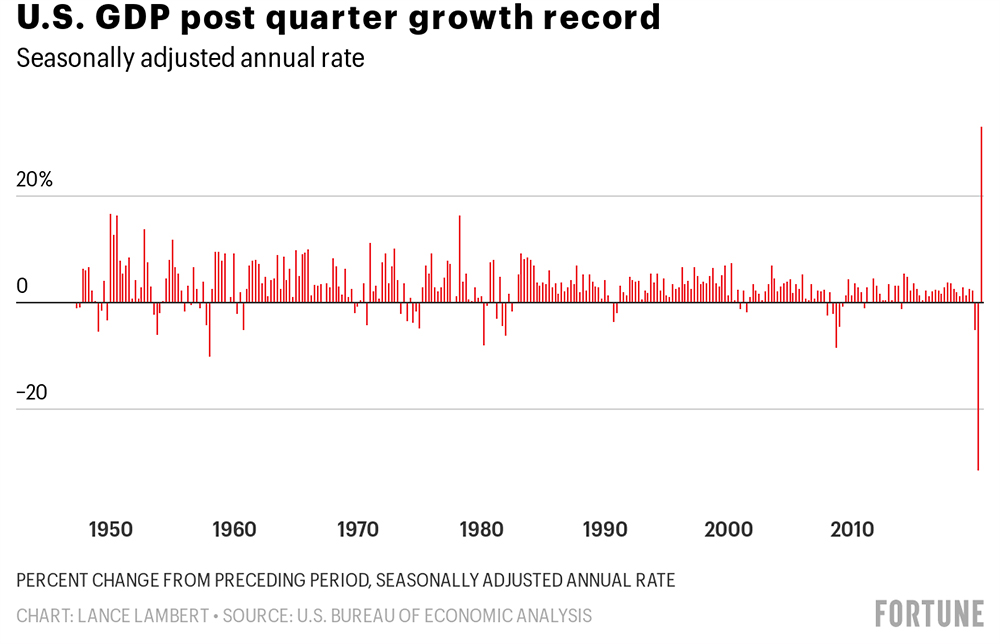美國(guó)近三個(gè)月的經(jīng)濟(jì)回升速度堪稱史上最快。
據(jù)美國(guó)經(jīng)濟(jì)分析局(U.S. Bureau of Economic Analysis)于10月29日公布的數(shù)據(jù),今年第三季度,即7月至9月期間,美國(guó)國(guó)內(nèi)生產(chǎn)總值(GDP)較去年同期增長(zhǎng)了33.1%。
早前的一、二季度,美國(guó)GDP曾經(jīng)遭受創(chuàng)記錄式的下跌,其年化降幅分別達(dá)到了5%及31.4%。這種跌幅一度讓眾多經(jīng)濟(jì)學(xué)家陷入恐慌,整個(gè)美國(guó)乃至全球似乎都站在了“經(jīng)濟(jì)大蕭條”的懸崖邊上。出人意料的是,自各州在夏季逐漸開放封鎖限制以來(lái),美國(guó)經(jīng)濟(jì)正在擺脫深度萎縮的泥沼,實(shí)現(xiàn)迅猛增長(zhǎng)。
第三季度GDP是美國(guó)總統(tǒng)大選前最后一個(gè)最重要的經(jīng)濟(jì)參考指標(biāo)。數(shù)據(jù)一經(jīng)發(fā)布,特朗普便開始慶祝起來(lái)。
GDP數(shù)據(jù)剛剛發(fā)布了。這是我國(guó)有史以來(lái)最好的成績(jī),沒(méi)有先例。明年會(huì)更好的!!!但是昏昏欲睡的拜登和他的增稅計(jì)劃顯然會(huì)毀了這一切。還好GDP數(shù)據(jù)在11月3號(hào)前公布,我太開心了!
— 唐納德?特朗普 (@realDonaldTrump) 2020年10月29日
但美國(guó)仍未走出困境。今年前兩個(gè)季度,美國(guó)折合成年率的GDP總值由21.8萬(wàn)億美元降至了19.5萬(wàn)億美元。這一季度,該數(shù)值雖然回升到了21.2萬(wàn)億美元左右,卻仍然低于年前。

事實(shí)上,美國(guó)已經(jīng)進(jìn)入經(jīng)濟(jì)復(fù)蘇瓶頸期。夏季解除封鎖之初,類似于牙醫(yī)診所、理發(fā)店這樣人流量較為有限的場(chǎng)所得以快速回歸,自5月起,美國(guó)共有1140萬(wàn)個(gè)工作崗位恢復(fù)常態(tài)。然而到了疫情后期,酒店、會(huì)所等人流量密集場(chǎng)所遲遲不得復(fù)業(yè),社會(huì)崗位增速由此放緩。目前美國(guó)仍然較疫情前縮減了1070萬(wàn)個(gè)工作崗位,其中380萬(wàn)個(gè)崗位正是集中在酒店及休閑娛樂(lè)業(yè)。
“第四季度的數(shù)據(jù)未必會(huì)有那么好看,到時(shí)候經(jīng)濟(jì)復(fù)蘇的脆弱面貌就會(huì)浮現(xiàn)出來(lái)。現(xiàn)時(shí)數(shù)據(jù)只是體現(xiàn)出了政府大規(guī)模財(cái)政刺激下的滯后效應(yīng),如果新冠確診病例繼續(xù)激增,那么這種效應(yīng)就會(huì)衰退。”穆迪投資者服務(wù)公司(Moody’s Investors Service)的副總裁馬德哈維?伯克利在GDP數(shù)據(jù)發(fā)布后寫道。
此外,雖然美國(guó)GDP出現(xiàn)了“V字型”回升,但就業(yè)率卻不容樂(lè)觀。美國(guó)9月只增了66.1萬(wàn)個(gè)崗位,如果按照這個(gè)速度,可能要到2022年,也就是花費(fèi)16個(gè)月才能夠恢復(fù)到疫情前水平。同時(shí)企業(yè)招聘步伐也將放緩,這意味著可能要到2023年甚至更遠(yuǎn)以后,才可以實(shí)現(xiàn)全面就業(yè)。
有常言道,股市走向不代表經(jīng)濟(jì)走向。借而用之則可見,GDP走向亦不代表人民生活走向。(財(cái)富中文網(wǎng))
編譯:陳怡軒
美國(guó)近三個(gè)月的經(jīng)濟(jì)回升速度堪稱史上最快。
據(jù)美國(guó)經(jīng)濟(jì)分析局(U.S. Bureau of Economic Analysis)于10月29日公布的數(shù)據(jù),今年第三季度,即7月至9月期間,美國(guó)國(guó)內(nèi)生產(chǎn)總值(GDP)較去年同期增長(zhǎng)了33.1%。
早前的一、二季度,美國(guó)GDP曾經(jīng)遭受創(chuàng)記錄式的下跌,其年化降幅分別達(dá)到了5%及31.4%。這種跌幅一度讓眾多經(jīng)濟(jì)學(xué)家陷入恐慌,整個(gè)美國(guó)乃至全球似乎都站在了“經(jīng)濟(jì)大蕭條”的懸崖邊上。出人意料的是,自各州在夏季逐漸開放封鎖限制以來(lái),美國(guó)經(jīng)濟(jì)正在擺脫深度萎縮的泥沼,實(shí)現(xiàn)迅猛增長(zhǎng)。
第三季度GDP是美國(guó)總統(tǒng)大選前最后一個(gè)最重要的經(jīng)濟(jì)參考指標(biāo)。數(shù)據(jù)一經(jīng)發(fā)布,特朗普便開始慶祝起來(lái)。
GDP數(shù)據(jù)剛剛發(fā)布了。這是我國(guó)有史以來(lái)最好的成績(jī),沒(méi)有先例。明年會(huì)更好的!!!但是昏昏欲睡的拜登和他的增稅計(jì)劃顯然會(huì)毀了這一切。還好GDP數(shù)據(jù)在11月3號(hào)前公布,我太開心了!
— 唐納德?特朗普 (@realDonaldTrump) 2020年10月29日
但美國(guó)仍未走出困境。今年前兩個(gè)季度,美國(guó)折合成年率的GDP總值由21.8萬(wàn)億美元降至了19.5萬(wàn)億美元。這一季度,該數(shù)值雖然回升到了21.2萬(wàn)億美元左右,卻仍然低于年前。
事實(shí)上,美國(guó)已經(jīng)進(jìn)入經(jīng)濟(jì)復(fù)蘇瓶頸期。夏季解除封鎖之初,類似于牙醫(yī)診所、理發(fā)店這樣人流量較為有限的場(chǎng)所得以快速回歸,自5月起,美國(guó)共有1140萬(wàn)個(gè)工作崗位恢復(fù)常態(tài)。然而到了疫情后期,酒店、會(huì)所等人流量密集場(chǎng)所遲遲不得復(fù)業(yè),社會(huì)崗位增速由此放緩。目前美國(guó)仍然較疫情前縮減了1070萬(wàn)個(gè)工作崗位,其中380萬(wàn)個(gè)崗位正是集中在酒店及休閑娛樂(lè)業(yè)。
“第四季度的數(shù)據(jù)未必會(huì)有那么好看,到時(shí)候經(jīng)濟(jì)復(fù)蘇的脆弱面貌就會(huì)浮現(xiàn)出來(lái)。現(xiàn)時(shí)數(shù)據(jù)只是體現(xiàn)出了政府大規(guī)模財(cái)政刺激下的滯后效應(yīng),如果新冠確診病例繼續(xù)激增,那么這種效應(yīng)就會(huì)衰退。”穆迪投資者服務(wù)公司(Moody’s Investors Service)的副總裁馬德哈維?伯克利在GDP數(shù)據(jù)發(fā)布后寫道。
此外,雖然美國(guó)GDP出現(xiàn)了“V字型”回升,但就業(yè)率卻不容樂(lè)觀。美國(guó)9月只增了66.1萬(wàn)個(gè)崗位,如果按照這個(gè)速度,可能要到2022年,也就是花費(fèi)16個(gè)月才能夠恢復(fù)到疫情前水平。同時(shí)企業(yè)招聘步伐也將放緩,這意味著可能要到2023年甚至更遠(yuǎn)以后,才可以實(shí)現(xiàn)全面就業(yè)。
有常言道,股市走向不代表經(jīng)濟(jì)走向。借而用之則可見,GDP走向亦不代表人民生活走向。(財(cái)富中文網(wǎng))
編譯:陳怡軒
The economy just experienced its fastest three months of growth in U.S. history.
In the third quarter, from July to September, GDP climbed 33.1% on an annualized basis, according to data released on October 29 by the U.S. Bureau of Economic Analysis.
This historic climb follows the U.S. record 31.4% annualized GDP decline in the second quarter and the 5% annualized decline in the first quarter. During that period economists around the world were in a panic and questioning if the United States—as well as the rest of the world—was on the cusp of an economic depression. But once states began to ease lockdown restrictions in the summer, the U.S. economy sprung from deep contraction to high growth.
It's the last major piece of economic data before Election Day, and President Trump was quick to celebrate the numbers.
GDP number just announced. Biggest and Best in the History of our Country, and not even close. Next year will be FANTASTIC!!! However, Sleepy Joe Biden and his proposed record setting tax increase, would kill it all. So glad this great GDP number came out before November 3rd.
— Donald J. Trump (@realDonaldTrump) October 29, 2020
But we're still in the hole. Over the course of the first two quarters, annualized U.S. GDP fell from $21.8 trillion to $19.5 trillion. In the third quarter that swung back up to about $21.2 trillion.
And the easy economic gains are over. When states reopened this summer, jobs at places of business without mass crowds, like dental offices and barber shops, came back quickly. In all, 11.4 million jobs have returned since May. But with the pandemic still raging across the nation, businesses like hotels and event venues are far from pre-pandemic employment levels. Indeed, the economy is still down 10.7 million jobs, including 3.8 million in leisure and hospitality.
"The fourth-quarter numbers may tell a less robust story, exposing the tenuous nature of this recovery. The lagged effects of fiscal support provided through the CARES Act are fading at a time when COVID cases are surging," wrote Madhavi Bokil, vice president of Moody’s Investors Service, following the GDP release.
But while GDP is seeing something closer to a V-shaped recovery—bouncing back nearly as fast as it fell—that isn't the case for U.S. employment. The U.S. added 661,000 jobs in September. If that pace were to continue, it would take over 16 months—into 2022—to recover all the jobs lost during the COVID-19 recession. The issue? That pace of hiring is expected to slow further, meaning a full employment recovery could take until 2023 or longer.
It's often said that the stock market isn't the economy. But it's also true that the economy—or at least the GDP—isn't us.






